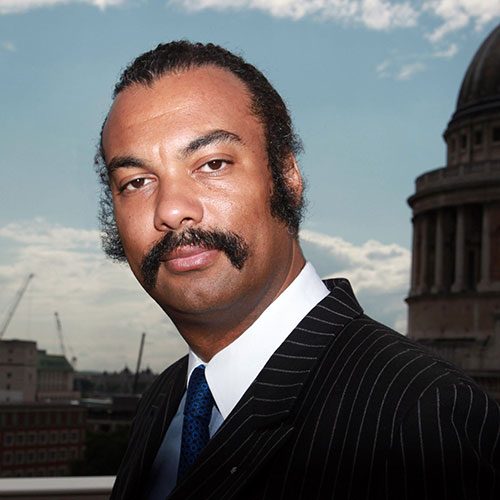This marks the first in a semi-regular feature in what I hope will be covering the wider aspects of the re-emergence of virtual reality into the commercial and consumer sector. My consultancy, KWP, and our news service The Stinger Report are beginning to be invited to a number of events where VR, and those VR headsets hoping to break into the market, are being demonstrated—many of these events would be totally off the radar of most of the VR community. With this series I hope to give a brief snapshot of the action, to give our readers a wider field of view on the immersive entertainment space.
As stated this feature is as a snapshot of the gatherings and the developments seen, but are not intended as a detailed blow-by-blow account, but more of a brief overview to chart the coming and going. If more detail is required, please email the team at Road to VR and they will be able to pass on the questions to me and I will attempt to answer where possible.
S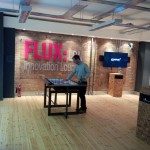 tarting off this feature—and a crowded April and May 2014—high profile conferences covering the emergence of various technologies and the launches of new business models.
tarting off this feature—and a crowded April and May 2014—high profile conferences covering the emergence of various technologies and the launches of new business models.
One of those new models was from marketing and promotion creation company Engage who opened their Flux Innovation Lounge in the City of London—along with the latest touchscreens and three-dimensional displays was nestled a VR demonstrator.
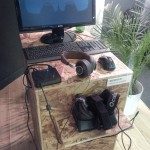 No self-respecting innovation showroom is complete without the appearance of a VR demonstrator—the Oculus Rift DK1 running a simple underwater demonstrator, being used as a primer for the type of immersive promotional material companies like Engage will be looking towards in the future.
No self-respecting innovation showroom is complete without the appearance of a VR demonstrator—the Oculus Rift DK1 running a simple underwater demonstrator, being used as a primer for the type of immersive promotional material companies like Engage will be looking towards in the future.
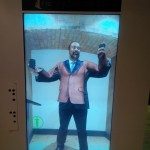 Engage is also demonstrated their augmented reality projects, such as the immersive video cloakroom, allowing buyers to try-on (virtually) various cloth selections mapped onto their image in the mirror in real time.
Engage is also demonstrated their augmented reality projects, such as the immersive video cloakroom, allowing buyers to try-on (virtually) various cloth selections mapped onto their image in the mirror in real time.
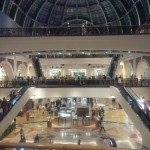 My consultancy is not totally London bound and we found ourselves in Dubai to attend the Dubai Entertainment Amusement & Leisure (DEAL) expo and conference in April – where we presented a conference session on new technology in the sector.
My consultancy is not totally London bound and we found ourselves in Dubai to attend the Dubai Entertainment Amusement & Leisure (DEAL) expo and conference in April – where we presented a conference session on new technology in the sector.
While enjoying some down time a group of delegates visited local amusement and attractions in the area, including the Mall of The Emirate – the vast entertainment and retail space (including its own snow park) also represented a glimpse of the Western future of retail space.
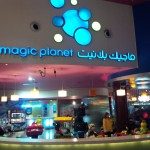 The venue is famous for its extensive entertainment zone—including the Magic Planet Family Entertainment Center (FEC). Along with a multitude of the latest simulators and amusement pieces, bowling and even a robot arm roller coaster simulator.
The venue is famous for its extensive entertainment zone—including the Magic Planet Family Entertainment Center (FEC). Along with a multitude of the latest simulators and amusement pieces, bowling and even a robot arm roller coaster simulator.
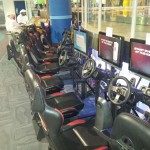 The venue also includes an extensive PC gaming zone, along with PCs set-up to play the latest WoW and FPS titles—the venue includes a RaceRoom PC racing car network simulator enclosure with some eight PC racing rigs hired for intense racing.
The venue also includes an extensive PC gaming zone, along with PCs set-up to play the latest WoW and FPS titles—the venue includes a RaceRoom PC racing car network simulator enclosure with some eight PC racing rigs hired for intense racing.
The operator of this venue is already looking towards the future and confirmed investigation of enhancing the racing rigs set-up with VR headsets and even VR enclosures. Interest in VR being deployed as an addition to the amusement mix is growing in popularity. What we see in the sophisticated UAE market will appear in the Western market soon after.
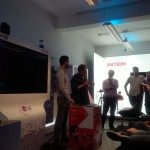 Returning to London, the popular Meetup scene of the VR community gathers momentum. The originator of these gatherings is the London Oculus VR / Developer Meetup—the April gathering saw the event moving from just being Oculus VR centric and covering all aspects of the VR emergence.
Returning to London, the popular Meetup scene of the VR community gathers momentum. The originator of these gatherings is the London Oculus VR / Developer Meetup—the April gathering saw the event moving from just being Oculus VR centric and covering all aspects of the VR emergence.
The meetup is organized by the team at Inition, another marketing and promotion concept creation studio with a strong background in this technology—a passion reflected in the wealth they bring to their meetups—the corporation famous for creating the Top Shop London Fashion Week VR promotion.
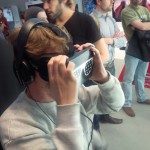 The VR community gathers in the corporation basement showroom along with some interesting presentations, ranging from the latest developments to the use of 360 degree image capture in virtual content—there is a chance to go hands-on with many demonstrations.
The VR community gathers in the corporation basement showroom along with some interesting presentations, ranging from the latest developments to the use of 360 degree image capture in virtual content—there is a chance to go hands-on with many demonstrations.
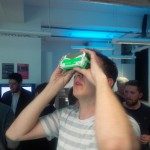 From the latest Rift DK1 immersion, to the latest 3D printed mobile phone VR unit—the kickstarter for the Altergaze, which successfully broke its original £25,000 goal. The Altergaze offers a perfect example of the community aspects of the new drive in VR, and a platform that could make VR as simple to view as picking up your mobile-phone!
From the latest Rift DK1 immersion, to the latest 3D printed mobile phone VR unit—the kickstarter for the Altergaze, which successfully broke its original £25,000 goal. The Altergaze offers a perfect example of the community aspects of the new drive in VR, and a platform that could make VR as simple to view as picking up your mobile-phone!
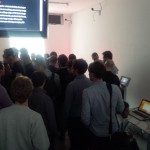 The interest in the gathered demonstrations reached fever pitch at the Inition gathering, fueled by the hospitality of the company with beer and pizza provided. Conversations go long into the night at the appropriately placed pub across the street.
The interest in the gathered demonstrations reached fever pitch at the Inition gathering, fueled by the hospitality of the company with beer and pizza provided. Conversations go long into the night at the appropriately placed pub across the street.
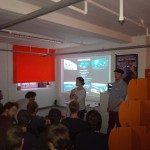 Another Meetup for the burgeoning VR community also located within the influential “Silicon Roundabout” area of London—which hopes to rival the ‘Silicon Valley’ of California in the U.S. The London Oculus Rift / VR Games Meetup took place in the Bossa Studios, a game development house with a drive for immersive entertainment and VR.
Another Meetup for the burgeoning VR community also located within the influential “Silicon Roundabout” area of London—which hopes to rival the ‘Silicon Valley’ of California in the U.S. The London Oculus Rift / VR Games Meetup took place in the Bossa Studios, a game development house with a drive for immersive entertainment and VR.
One of the growing meetup’s to the VR community in the capital, the event has proven equally as passionate about the new technology using much of their contacts in the consumer games scene to gain VR momentum.
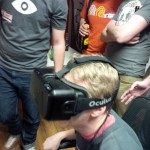 The recent meetup saw the first appearance in the UK publically of an Oculus Rift DK2— the equally newly minted Oculus VR ‘Developer Relations Manager’ (Callum Underwood) — his first outing walking the VR community gathered at the Bossa Studios through the DK2.
The recent meetup saw the first appearance in the UK publically of an Oculus Rift DK2— the equally newly minted Oculus VR ‘Developer Relations Manager’ (Callum Underwood) — his first outing walking the VR community gathered at the Bossa Studios through the DK2.
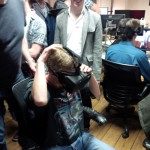 As would be expected, a strong level of interest by the gathered who hope to get their eyeballs into the new development kit system. Running the underworld seated demonstration—hot from its first appearance at CES 2014—the ability to also experience the new positional tracking got many tongues wagging.
As would be expected, a strong level of interest by the gathered who hope to get their eyeballs into the new development kit system. Running the underworld seated demonstration—hot from its first appearance at CES 2014—the ability to also experience the new positional tracking got many tongues wagging.
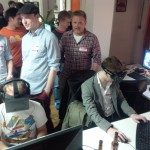 The DK2 was not the only star of the evening at Bossa, with a number of the latest demonstrations on display allowing the gathering to get to grips with the speed of development and innovation that seems to have been gathered in the Capital.
The DK2 was not the only star of the evening at Bossa, with a number of the latest demonstrations on display allowing the gathering to get to grips with the speed of development and innovation that seems to have been gathered in the Capital.
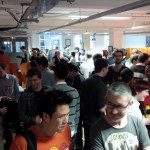 The crowded Bossa Studio venue offered hospitality and a high level of discussion on the current state of VR development and its implications for the conventional consumer games scene. Little did many of us know that we were only a matter of feet away from another VR exclusive to rival the appearance of the DK2!
The crowded Bossa Studio venue offered hospitality and a high level of discussion on the current state of VR development and its implications for the conventional consumer games scene. Little did many of us know that we were only a matter of feet away from another VR exclusive to rival the appearance of the DK2!
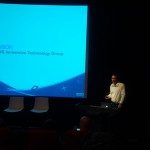 The following week a selected band of consumer developers were gathered at the Dolby Studio screening rooms in the heart of London’s Soho. Selected invites issued by the Intent Media publication Develop to what was dubbed ‘An Audience with Project Morpheus‘.
The following week a selected band of consumer developers were gathered at the Dolby Studio screening rooms in the heart of London’s Soho. Selected invites issued by the Intent Media publication Develop to what was dubbed ‘An Audience with Project Morpheus‘.
Invites to attend were incredibly limited, with various unusual excuses used why some were allowed to attend and others were not—I was lucky enough to be offered an invite by a contact that was unable to attend for themselves. And the many empty seats within the Dolby screening room spoke of some issue with allocations.
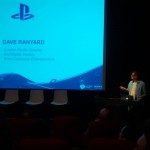 Presenting during the session were Sony representatives that worked on Project Morpheus directly over the last three years, or are charged with the organization of the developer community.
Presenting during the session were Sony representatives that worked on Project Morpheus directly over the last three years, or are charged with the organization of the developer community.
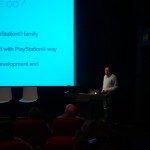 The gathering was stated categorically as a means for those not familiar with VR and the requirements of game development in the virtual environment to gain an understanding of how Sony see the best approach towards utilizing the hardware.
The gathering was stated categorically as a means for those not familiar with VR and the requirements of game development in the virtual environment to gain an understanding of how Sony see the best approach towards utilizing the hardware.
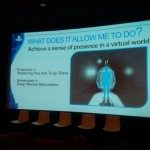 The Sony representatives made it clear from the start that they would not be policing the space and wanted to offer advice and best practice to ensure that the issues of sim-sickness and inappropriate content would not become an issue.
The Sony representatives made it clear from the start that they would not be policing the space and wanted to offer advice and best practice to ensure that the issues of sim-sickness and inappropriate content would not become an issue.
Sony confirmed that they have achieved incidents of sim-sickness with their system and had built-up lessons learned, including from their earlier work with the Glasstron and HMZ-series, which will now be applied to Project Morpheus development.
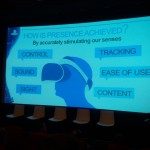 The fundamentals of ‘Control’, ‘Tracking’, ‘Sound’, ‘Ease of Use’, ‘Sight’ and ‘Content’ will be driving the development in this space. The need for ‘presence’, a watchword borrowed from Valve by the Sony team, and the avoidance of breaking this perception were discussed.
The fundamentals of ‘Control’, ‘Tracking’, ‘Sound’, ‘Ease of Use’, ‘Sight’ and ‘Content’ will be driving the development in this space. The need for ‘presence’, a watchword borrowed from Valve by the Sony team, and the avoidance of breaking this perception were discussed.
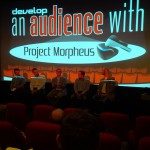 In a panel discussion at the end of the presentations developers already using the hardware were brought on stage to give their views—and surprise surprise— Bossa Studio was among them. They have had at their facility one of the few Project Morpheus development systems, working on a number of projects and demonstrators.
In a panel discussion at the end of the presentations developers already using the hardware were brought on stage to give their views—and surprise surprise— Bossa Studio was among them. They have had at their facility one of the few Project Morpheus development systems, working on a number of projects and demonstrators.
 The gathered audience asked many questions touching on delivery of content and restrictions, but the first and most heartfelt question was “…will we get a chance to try Project Morpheus now?” Sheepishly the Sony representatives had to say no—and that the only Project Morpheus systems available were being used for Sony internal presentations.
The gathered audience asked many questions touching on delivery of content and restrictions, but the first and most heartfelt question was “…will we get a chance to try Project Morpheus now?” Sheepishly the Sony representatives had to say no—and that the only Project Morpheus systems available were being used for Sony internal presentations.
Attempts to placate the disappointment of the gathered audience was seen with the free bar—and along with this the heavy promotion of Develop magazine; who had moderate and facilitated this non-VR VR demonstration—and who also sported a VR exclusive in their latest issue handed out at the event!
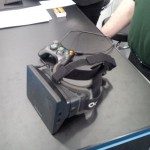 The appearance of VR has accelerated as the next big thing—though many of these developments would have been underway before the momentous Facebook investment—the ability to associate with the buzz in VR does not hurt. Explaining where many of the 75,000 DK1 really went.
The appearance of VR has accelerated as the next big thing—though many of these developments would have been underway before the momentous Facebook investment—the ability to associate with the buzz in VR does not hurt. Explaining where many of the 75,000 DK1 really went.
Moving across London and in May was held the Museum + Heritage (M+H) conference and exhibition—the major event for the curators and operators of museum, galleries, and heritage sites in the UK and Europe. Taking place at this event at the Cross Design Group booth was the ubiquitous Oculus Rift DK1.
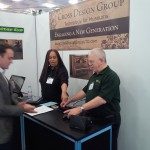 The American based developer of content for the museum, visitor center, and gallery market has also been investing in getting a better understand of the opportunities that VR could offer the museum audience of the future.
The American based developer of content for the museum, visitor center, and gallery market has also been investing in getting a better understand of the opportunities that VR could offer the museum audience of the future.
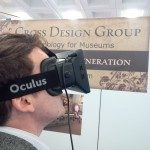 The operation has a walk through presentation of a mythical temple, allowing the user to navigate around the impressively modeled environment. The executives on booth confirmed that they had had much interest in the representation—even receiving suggestions to include Avatar to interact with while traversing the environment.
The operation has a walk through presentation of a mythical temple, allowing the user to navigate around the impressively modeled environment. The executives on booth confirmed that they had had much interest in the representation—even receiving suggestions to include Avatar to interact with while traversing the environment.
The ability to represent some 90% of the museum scene’s ‘warehoused’, artifacts as well as the ability to navigate historical environment, are a draw to VR application of ‘edutainment’.
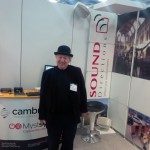 One of the speakers at M+H was a pioneer in the audio business, MorrowSounds and their legendary company founder Charlie Morrow. The great man gave me some of his valuable time before his packed presentation and we discussed the need for immersive audio—an element that seems to have been neglected from the majority of Oculus and Project Morpheus discussions.
One of the speakers at M+H was a pioneer in the audio business, MorrowSounds and their legendary company founder Charlie Morrow. The great man gave me some of his valuable time before his packed presentation and we discussed the need for immersive audio—an element that seems to have been neglected from the majority of Oculus and Project Morpheus discussions.
The importance of Spatial Audio / Binaural Audio to set the scene and immerse the audience is the stock-en-trade for MorrowSounds, applying their extensive experience in the venue, cinema, and events business (including many historic buildings and galleries).
Charlie was kind enough to reveal exclusively that they are working on their own VR development tool to offer true Binaural Audio to any VR application, marrying seamlessly with the latest development tools such as Unity3D. This will be an available toolset—filling the vacuum that the HMD manufacturers seem to have created, and offer a level of dimension to VR so essential for true ‘presence’.
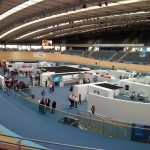 Cross town to the next conference and presentation, and we found ourselves at the famous London Olympic Velopark—one of the iconic buildings of the stupendous 2012 London Olympic games. The versatile site has turned over to electronics-giant NEC and their suppliers, who held their annual NEC Solution Showcase, a gathering of the latest technology for the commercial sector ranging from screen signage, retail, media, control-rooms, large displays, and leisure entertainment.
Cross town to the next conference and presentation, and we found ourselves at the famous London Olympic Velopark—one of the iconic buildings of the stupendous 2012 London Olympic games. The versatile site has turned over to electronics-giant NEC and their suppliers, who held their annual NEC Solution Showcase, a gathering of the latest technology for the commercial sector ranging from screen signage, retail, media, control-rooms, large displays, and leisure entertainment.
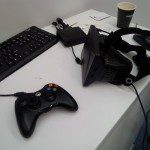 In the leisure entertainment zone the marketing and promotion content creation company Smart Cookie presented their expertise, able to offer augmented reality audience entertainment vending kiosks, or interactive promotional systems for airport lounges.
In the leisure entertainment zone the marketing and promotion content creation company Smart Cookie presented their expertise, able to offer augmented reality audience entertainment vending kiosks, or interactive promotional systems for airport lounges.
The company also brought to the event a Oculus Rift DK1 and the rollercoaster demonstrator—offering an opportunity for the high powered executives walking the showcase floor a chance to experience the opportunity that VR offers.
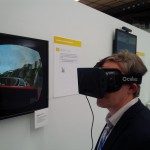 Speaking to the executives at Smart Cookie, they were still looking for the best application of VR into the marketing and promotional space. The reality of VR as a medium in this sector has yet to be proved beyond a novelty value. But there is a level of interest that will grow the more the sector comes to understand the opportunities that VR brings to the table.
Speaking to the executives at Smart Cookie, they were still looking for the best application of VR into the marketing and promotional space. The reality of VR as a medium in this sector has yet to be proved beyond a novelty value. But there is a level of interest that will grow the more the sector comes to understand the opportunities that VR brings to the table.
We look forward to covering further developments including a possible visit down to Brighton’s first VR Meetup, and a report form a coming visit to the States in the next feature soon.
Disclaimer – Images are the exclusive property of KWP Limited & The Stinger Report (TSR) 2014 – use without permission will be actionable. All brands and logos are the respective properties of their owners. The views expressed are those of the author and do not reflect those of KWP, TSR, DNA Association or represented clients.
About the Author – Kevin Williams has an extensive background in the development and sales of the latest amusement and attraction applications and technologies. The UK born specialist in the pay-to-play scene; is well-known through his consultancy KWP; and as a prolific writer and presenter (along with his own news service The Stinger Report), covering the emergence of the new entertainment market. Kevin has co-authored a book covering the sector called ‘The Out-of-Home Interactive Entertainment Frontier’ (published by Gower). And is the founding chairman of DNA Association, focuses on the digital Out-of Home interactive entertainment sector. Kevin can be reached at – kwp@thestingerreport.com – http://www.thestingerreport.com

